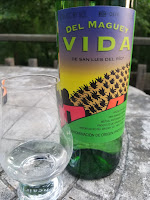Sud-Ouest France (south-West, France) is a large territorial zone stretching just southwest of Bordeaux to the Atlantic Ocean and bordering the Pyrenees to the south. It incorporates several administrative regions, diverse geographic areas, and multiple wine grapes and styles. This includes sweet wines from Jurancon and Monbazillac; tannic, full-blooded reds from Cahors (Côt aka Malbec) and Madiran (Tannat); sparkling wines from Gaillac; and a wide range of dry white wines.
According to wine-searcher.com, "The soils, climates, and topography of the South West are as wide-ranging as its wines. The presence of the Atlantic Ocean and the Mediterranean Sea means that much of the region has a maritime climate, but there are inland areas that make use of the drier, hotter summers created by their more continental climate. The Garonne, Dordogne, Lot, and Tarn rivers bring alluvial soil types (clay, sand, gravel) to much of the region. Other vineyard areas, such as Irouleguy and the wider Bearn are also set on the steep slopes and foothills of the Pyrenees mountains, offering a variety of stone types, along with varying altitudes and aspects".
A recent Hopwine exhibition included a couple wineries from the Sud-Ouest starting with Vignobles Arbeau. The winery and estate (Château Coutinel) are located in the village of Labastide Saint Pierre, within the AOP Fronton, with the village located 42km north of Toulouse and about equidistant between the Atlantic Ocean and the Mediterranean Sea. They also range beyond AOP Fronton to other South-West domains: AOP Gaillac, IGP Comté Tolosan, and IGP Côtes du Tarn. Our friends at Grape Experiences have a post concerning the winery's history and signature Négrette grape.
AOP Fronton is an appellation to the north of Toulouse known for its rustic red wines (around 85 percent of production) in addition to smaller amounts of rosé. At least 50 percent of any Fronton vineyard must be planted with the
Negrette grape (40% of any blended wine). Since the berries are small and tightly bundled, they are susceptible to powdery mildew and grey rot. Thus, the vines prefer hot, dry growing conditions and thrive in Fronton's dry, semi-continental climate. It is also particularly fond of the region's acidic, sandy clay boulbène soil type.
Chateau Coutinel France - Sud-Ouest AOC Fronton Rosé 2020
This is a blend of 70% Négrette, 15% Syrah, and 15% Gamay grown on boulben, sandy-silt, and sometimes gravely soils. This is a pleasant wine, candied cherry aroma, velvety texture, and lifting acids.
Chateau Coutinel France - Sud-Ouest AOC Fronton 2019
Same blend and soil types as the rosé showing fresh sizzling raspberries. Poprocks?
Chateau Coutinel Négrette / On L'appelle Négrette France - Sud-Ouest Fronton 2019
100% Negrette grown on same soil types. This is a delicious wine, juicy and dense blackberries, some licorice, with suitable tannins and acids.
IGP Comte Tolosan is a large sub-region in the Sud-Ouest and encompasses 12 administrative departments, including the sub-regions of Jurançon, Cahors and Armagnac. The IGP label provides a geographical classification to wines that do not classify for the AOC-level appellations due to the grape variety or winemaking style. "Most IGP-related viticulture takes place in the center of the basin, along the course of the Garonne river. Old alluvial terraces provide well-drained, rocky environments for the vines, allowing for good flavor concentration in the grapes and deep, healthy root systems".
One popular grape in the IGP and other sub-regions is Braucol, a member of the Carmenets family and originating in the Spanish Basque Country. It is thought to have migrated to the region via pilgrims traveling the Way of Saint James. Specifically, it was spread by the Benedictine monks of Madiran and Conques who had recognized its rusticity allowing its cultivation in the Pyrenees and Aveyron. A synonym is Fer Servadou translating to wild and keeps well because it's a lambrusque (wild vine) and is highly resistant to mold.
Domaine De Coutinel France - Sud-Ouest IGP Comté Tolosan Braucol 2020
This 100% Braucol wine begins with slight pepper but retains a soft elegance that carries through the finish.
AOP Gaillac is a historic wine-producing region located northeast of Toulouse and covers 64 communes spread out for roughly 20km (12 miles) from the town of Gaillac on the Tarn river. A further nine communes within the appellation lie on the other side of the town of Albi, on the eastern edge of the main winegrowing area.
Duras – Fer – Syrah is the classic Gaillac wine blend with the Fer referring to Braucol. Together these three varieties make up at least 60 percent of any Gaillac red or rosé wine. Duras is an ancient grape variety, thought to have been introduced to France by the Romans more than 2000 years ago. In Sud-Ouest France, notably around Gaillac, it produces well-structured red wines full of color and alcohol.
Domaine Vaillieres France - Sud-Ouest AOP Gaillac 2019
This blend of 50% Braucol, 25% Duras, and 25% Syrah is from grapes from clay and limestone soils on the right bank of the Tarn River. It is very rustic, with a spicy-stoney character accentuated with a strong tannic backbone. A knockout.











































